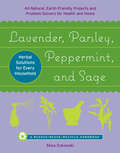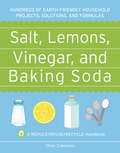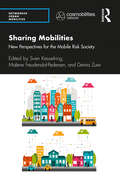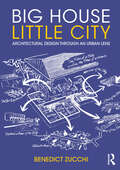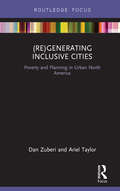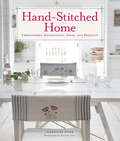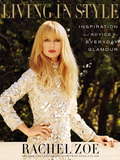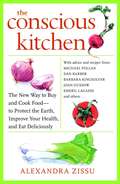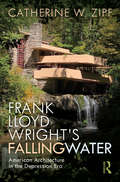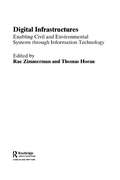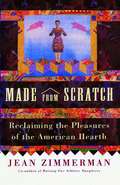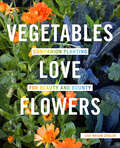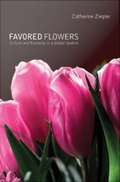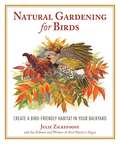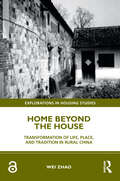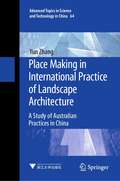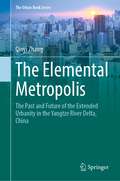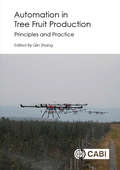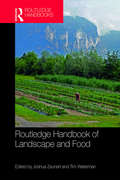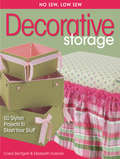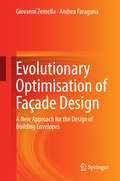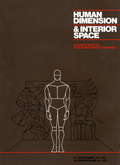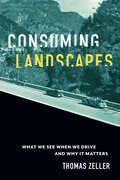- Table View
- List View
Lavender, Parsley, Peppermint, and Sage: Herbal Solutions for Every Household
by Shea ZukowskiTap into the antibacterial and antiviral properties of herbs to keep your family healthy and your home clean—from stress relievers to room fresheners.Herbs offer powerful, natural, earth-friendly solutions for all sorts of home, garden, and personal needs. This invaluable guide gathers hundreds of simple recipes for herb-based formulas that are safe and effective for use in every home. Herbs have been used for practical purposes for thousands of years—natural and proven, they are a welcome alternative to man-made, often toxic chemicals.Plus, they are easy and enjoyable to work with: herbs can be crushed, boiled, layered, and/or mixed with oil or water or other handy household ingredients to make hundreds of useful home products, for everything from cleaning to personal care.Organized by use, this convenient volume presents a wealth of helpful herbal solutions. For each entry, readers will find an introduction describing the best uses for this product, a full ingredient list, step-by-step instructions for preparing the formula, information on storage, and advice on how to use it.A wonderful gift book and useful reference combined, Lavender, Parsley, Peppermint, and Sage is an indispensable guide for a greener, healthier lifestyle.
Salt, Lemons, Vinegar, and Baking Soda: A Reduce/Reuse/Recycle Handbook
by Shea ZukowskiLearn how these four natural, everyday items can accomplish hundreds of household tasks—from personal to pet care, kitchen to outdoor uses.Salt, lemons, vinegar, and baking soda are the all-you-need all-stars of the home. From personal hygiene and grooming to household cleaning and gardening, this powerful quartet has a long and storied history of usefulness that is also utterly modern and of-the-moment: green, cheap, and effective.Beginning with a brief introduction to each of these amazing substances, this comprehensive book of household hints (useful indoors and out, for people and for pets) offers hundreds of smart solutions for better living. Combining one part science with one part practicality, and a dash of fun, this indispensable, earth-friendly reference is a must-have in any home.
Sharing Mobilities: New Perspectives for the Mobile Risk Society (Networked Urban Mobilities Series)
by Dennis Zuev Sven Kesselring Malene Freudendal-PedersenSharing Mobilities focuses on the emergence of future sustainable and collaborative mobility cultures. At the intersection of physical and virtual capacity and access to people, goods, ideas, and services, this book poses fundamental challenges and opportunities for governance, economy, planning, and identity. The future of new collaborative forms of consumption and sharing would play a key role in the organization of everyday life and business. Sharing mobilities is more than simply sharing transport, and its diverse impacts on society and the environment demand thorough theory-led sociological research. With an extensive global range, the contributors present radical manifestations of sharing capacities throughout diverse countries, including Germany, Denmark, Japan, and Vietnam. The phenomenon of mobility is highly actual and social as well as politically relevant and urging. This collection focuses on open questions from the perspective of the mobilities turn while presenting state-of-the-art theory-based articles with applied perspectives. An ideal read for scholars based in social science and the interdisciplinary research on mobility, transports, and sharing economy. Sociologists, geographers, economists, urban governance researchers, and research students would also find this book of interest.
Big House Little City: Architectural Design Through an Urban Lens
by Benedict ZucchiCombining architectural and urban thinking in an unusual and engaging way, this book presents an integrated approach to architectural theory and design. Leon Battista Alberti’s assertion in his famous Renaissance treatise that ‘the city is like a big house, and the house is in turn like a little city’ forms the springboard for a series of reflections on architecture’s relationship with urbanism and how their once intimate symbiosis, unravelled by International Style Modernism, can be recovered. Explicit references to Alberti’s house-city phrase have been made by figures as diverse as the architects Louis Kahn, Aldo Van Eyck, Denys Lasdun and Niels Torp and novelist Italo Calvino. But, as the book shows, thinking of buildings as little cities provides a new lens through which to reappraise the contributions of many other architects, including Le Corbusier, Frank Lloyd Wright, Alvar Aalto, Eliel Saarinen, Bernard Rudofsky, Hans Scharoun, Leon Krier, Fumihiko Maki, Charles Correa and Team 10. In doing so, the author identifies common themes that form an unexpected bridgehead between the urban and architectural approaches of Antiquity, the Middle Ages, Renaissance and 20th century. The book explores buildings from across the globe, including lesser-known projects, such as Wright’s unbuilt house in Italy or Saarinen’s master plan for Cranbrook Academy, as well as more recent projects by Niels Torp, Behnisch Architekten, Sou Fujimoto, Peter Barber and WOHA. It concludes with practical case studies of residential, health, education and workplace projects from different countries, fulsomely illustrated with many drawings and photographs. These show how architectural design viewed through an urban lens provides a conceptual framework for breaking down the scale of large buildings and integrating them with their context. And crucially, these also show a very accessible way of explaining evolving designs to the intended users and eliciting their participation in the design process. The book offers a compelling approach to the design of projects at all scales, within an ecological perspective: the sense that big and small, cities and buildings must be approached holistically if we are to reverse the degradation and depletion of our habitat, both natural and man-made.
(Re)Generating Inclusive Cities: Poverty and Planning in Urban North America
by Dan Zuberi Ariel Judith TaylorAs suburban expansion declines, cities have become essential economic, cultural and social hubs of global connectivity. This book is about urban revitalization across North America, in cities including San Francisco, Toronto, Boston, Vancouver, New York and Seattle. Infrastructure projects including the High Line and Big Dig are explored alongside urban neighborhood creation and regeneration projects such as Hunters Point in San Francisco and Regent Park in Toronto. Today, these urban regeneration projects have evolved in the context of unprecedented neoliberal public policy and soaring real estate prices. Consequently, they make a complex contribution to urban inequality and poverty trends in many of these cities, including the suburbanization of immigrant settlement and rising inequality. (Re)Generating Inclusive Cities wrestles with challenging but important questions of urban planning, including who benefits and who loses with these urban regeneration schemes, and what policy tools can be used to mitigate harm? We propose a new way forward for understanding and promoting better urban design practices in order to build more socially just and inclusive cities and to ultimately improve the quality of urban life for all.
Hand-Stitched Home
by Caroline ZoobA Hand-Stitched Home is one in which lovely embroidered designs personalize and enliven the space. These designs can be tiny embroidered details, decorative trims, or large, colorful pictures. In this uniquely beautiful volume, five sections and twenty-four embroidery projects reveal how to turn your living space into an elegant, inviting Hand-Stitched Home. Making PicturesA needle and thread are perfect tools to paint pictures--like a countryside image to adorn bookends or a nautical scene to transform a scrap of fabric into artwork so lovely that it begs to be framed. On the EdgeSimple decorative details can add beauty in the most unexpected of places. A light green print of ivy can embellish the edge of a chair cover, a print of kitchen supplies can makes shelf edging easy on the eyes. At the TableThe kitchen is the heart of the home and the table is the heart of the kitchen. A vibrant pinwheel design makes a stunning tablecloth runner, names or initials on placemats will bring the whole family together at mealtime. The Soft StuffNothing lends itself as easily to embroidery as blankets and pillows. Textured violets on a pillow or bright, scattered flowers on a white quilt fill living rooms and bedrooms with comfort and cheer. At the WindowEmbroidery allows everyday objects to add grace to the home. A white thread design on a sheer curtain or an embroidered pelmet are delightful accessories to guide sunshine into the home.
Secrets of the Garden: Food Chains and the Food Web in Our Background
by Kathleen Weidner ZoehfeldPerfect for Earth Day and spring planting season--an outstanding book about backyard science the whole family will appreciate. Alice's family plants a vegetable garden each spring, and this budding naturalist reports all she sees about how the plants grow, what insects come to eat the plants, and what birds and animals come to eat the insects. It's the food chain, right in her own backyard! While Alice's narrative is simple and engaging, science concepts are presented in more depth in sidebars by a pair of very knowledgeable (and highly amusing) chickens! Noted science writer Kathleen Weidner Zoehfeld knows how to layer information to make it accessible to a wide range of readers and useful for educators. And illustrator Priscilla Lamont's funny, friendly paintings make this a garden everyone will want to explore. Kids will eat up this wonderful book of backyard science—and perhaps they'll even be inspired to eat their vegetables!
Living In Style: Advice and Inspiration for Everyday Glamour
by Rachel ZoeAn unparalleled fixture in the fashion world, Rachel Zoe is a distinguished stylist, editor and designer, renowned for her effortless take on glamour. Her illustrious career has flourished as she has continually proven herself to be an integral part in shaping the image of Hollywood's A-list. As a reality television star, Rachel instantly catapulted from a behind-the-scenes stylist to a household name by documenting her burgeoning career and providing access into the previously unseen world of fashion, as well as her previously unseen personal world. Rachel's ever-growing audience loves to watch her every move so they can incorporate just a little bit of her unique sophistication into their own lives. In LIVING IN STYLE, Rachel tells readers exactly how to do just that.From beauty and home design to entertaining, travel, and, of course, fashion, Rachel gives readers insight on every aspect of lifestyle. As she looks to her own past and where she has drawn inspiration over the course of her career - and her life - readers will learn how to feel fabulous, too. Filled with never-before-seen photos from Rachel's personal collection and tips from colleagues, celebrities, family members and more, this book will be like none other. To borrow one of the author's trademark phrases, it will be 'maj!'.
The Conscious Kitchen: The New Way to Buy and Cook Food - to Protect the Earth, Improve Your Health, and Eat Deliciously
by Alexandra ZissuYour everyday food choices can change the world--and make meals taste better than ever For anyone who has read The Omnivore's Dilemma or seen Food, Inc. and longs to effect easy green changes when it comes to the food they buy, cook, and eat, The Conscious Kitchen is an invaluable resource filled with real world, practical solutions. Alexandra Zissu walks readers through every kitchen-related decision with three criteria in mind: what's good for personal health, what's good for the planet, and what tastes great. Learn, among other things, how to: - Keep pesticides, chemicals, and other harmful ingredients out of your diet- Choose when to spend your dollars on organic fruit and when to buy conventionally grown- Avoid plastic--including which kinds in particular and why- Figure out what seafood is safe to eat and is sustainable- Use COOL (country of origin labels) to your advantage- Determine if a vegetable is genetically modified just from reading its PLU (price look up) code- Decipher meat labels in the supermarket- Cook using the least energy--good for the earth and your wallet- Eat locally, even in winter - Understand what "natural" and other marketing terms really mean- Buy packaged foods wisely Navigate farmers' markets, giant supermarkets, and every shop in between to find the freshest and healthiest local ecologically grown and produced meat, dairy, fruits, and vegetables--no matter where you live With The Conscious Kitchen as your guide, you will never again stand in the market bewildered, wondering what to buy. You can feel confident you are making the best possible choices for you, your family, and our planet. ALEXANDRA ZISSU writes about green living, food, and parenthood. She is the author of The Conscious Kitchen, coauthor of The Complete Organic Pregnancy, and contributes the "Ask an Organic Mom" column to The DailyGreen.com. Her stories have appeared in The New York Times, The Green Guide, Cookie, Details, Bon Appétit, Self, and Health, among other publications. She is also a public speaker and "greenproofer," an eco-lifestyle consultant. Visit her website, www.alexandrazissu.com.
Frank Lloyd Wright’s Fallingwater: American Architecture in the Depression Era
by Catherine W ZipfFrank Lloyd Wright’s Fallingwater explores the relationship between the economic tumult in the United States in the 1930s, Frank Lloyd Wright, and the construction of his most famous house, Fallingwater. The book reinterprets the history of this iconic building, recognizing it as a Depression-era monument that stands as a testimony to what an American architect could achieve with the right site, client, and circumstance, even in desperate economic circumstances. Using newly available resources, author Catherine W. Zipf examines Wright’s work before and after Fallingwater to show how it was influenced by the economic climate, public architectural projects of the Great Depression, and America’s changing relationship with Modernist style and technology. Including over 50 black-and-white images, this book will be of great interest to students, historians, and researchers of art, architecture, and Frank Lloyd Wright.
Digital Infrastructures: Enabling Civil and Environmental Systems through Information Technology (Networked Cities Series)
by Rae Zimmerman Thomas HoranAn invisible network of digital technology systems underlies the highly visible networks of roads, waterways, satellites, and power-lines. Increasingly, these systems are becoming the "infrastructure's infrastructure," providing a crucial array of data on network demand, performance, reliability, and security. Digital Infrastructures presents an interdisciplinary analysis of the technological systems that envelop these networks. The book balances analyses of specific civil and environmental infrastructures with broader policy and management issues, including the challenges of using IT to manage these critical systems under crises conditions.
Made from Scratch: Reclaiming the Pleasures of the American Hearth
by Jean ZimmermanA stunning celebration and reappraisal of the importance of "women's work," Made from Scratch addresses the tug that many Americans feel between our professional and private lives. In this stunning celebration and reappraisal of the importance of "women's work," acclaimed journalist Jean Zimmerman poignantly addresses the tug that many Americans of the twenty-first century feel between our professional and private lives. With sharp wit and intelligence, she offers evidence that in the current domestic vacuum, we still long for a richer home life -- a paradox visible in the Martha Stewart phenomenon, in the continuing popularity of women's service magazines such as Better Homes and Gardens, Family Circle, and Ladies' Home Journal -- whose combined circulation of over 17 million is nearly twice the combined circulation of Time, Newsweek, and U.S. News & World Report -- and the booming business of restorations, where onlookers get a hands-on view of domestic life as it flourished in past centuries. This book is about the ways home traditions passed from one generation to the next -- baking a birthday cake from scratch, cherishing family heirlooms, or discovering the satisfaction of piecing a quilt -- sustain our souls, especially in our ever more processed, synthetic world, where we buy "homemade" goods and fail to see the irony in that.Made from Scratch tells the story of the unsung heroines of the hearth, investigating the history of female domesticity and charting its cultural changes over centuries. Zimmerman traces the lives of her own family's homemakers -- from her tiny but indomitable grandmother, who managed a farm, strangled chickens with her bare hands, and sewed all the family clothing, to her mother, who rejected her country upbringing yet kept a fastidious suburban home where the gender divide stayed firmly in place, to her own experiences as a wife and mother weaned on the Women's Movement of the 1970s, with its emphatic view that housework was a dirty word and that the domestic sphere was to be fled rather than cherished. In this book Zimmerman questions the unexamined trade-off we have made in a shockingly brief time span, as we've "progressed" from home-raised chickens to frozen TV dinners to McNuggets from the food court at the mall. What is lost when we no longer engage, as individuals and as a community, in the ancient rituals of food, craft, and shelter?
Made from Scratch
by Jean ZimmermanIn this stunning celebration and reappraisal of the importance of "women's work," acclaimed journalist Jean Zimmerman poignantly addresses the tug that many Americans of the twenty-first century feel between our professional and private lives. With sharp wit and intelligence, she offers evidence that in the current domestic vacuum, we still long for a richer home life -- a paradox visible in the Martha Stewart phenomenon, in the continuing popularity of women's service magazines such as Better Homes and Gardens, Family Circle, and Ladies' Home Journal -- whose combined circulation of over 17 million is nearly twice the combined circulation of Time, Newsweek, and U.S. News & World Report -- and the booming business of restorations, where onlookers get a hands-on view of domestic life as it flourished in past centuries. This book is about the ways home traditions passed from one generation to the next -- baking a birthday cake from scratch, cherishing family heirlooms, or discovering the satisfaction of piecing a quilt -- sustain our souls, especially in our ever more processed, synthetic world, where we buy "homemade" goods and fail to see the irony in that.Made from Scratch tells the story of the unsung heroines of the hearth, investigating the history of female domesticity and charting its cultural changes over centuries. Zimmerman traces the lives of her own family's homemakers -- from her tiny but indomitable grandmother, who managed a farm, strangled chickens with her bare hands, and sewed all the family clothing, to her mother, who rejected her country upbringing yet kept a fastidious suburban home where the gender divide stayed firmly in place, to her own experiences as a wife and mother weaned on the Women's Movement of the 1970s, with its emphatic view that housework was a dirty word and that the domestic sphere was to be fled rather than cherished. In this book Zimmerman questions the unexamined trade-off we have made in a shockingly brief time span, as we've "progressed" from home-raised chickens to frozen TV dinners to McNuggets from the food court at the mall. What is lost when we no longer engage, as individuals and as a community, in the ancient rituals of food, craft, and shelter?
Vegetables Love Flowers: Companion Planting for Beauty and Bounty
by Lisa Mason Ziegler“Does a marvelous job of taking you down the garden path of the ins and outs of companion planting.” —Julie Bawden-Davis, Community Table @ Parade.comFight garden pests and increase your yields the natural way with this tried-and-true technique! Planting vegetables and flowers together is one of the oldest ways to create a healthy, bountiful garden. Adding flowers to your food garden improves biodiversity, enhances pollination, and increases the numbers of beneficial pest-eating insects—with the bonus of providing beautiful bouquets of cut flowers to brighten your home and give to your family and friends. Vegetables Love Flowers explains the benefits of interplanting flowers and vegetables; offers detailed advice on how to add a cutting garden of vibrant annuals to your vegetable garden; gives profiles of a range of pollinators and beneficial predators; and provides plenty of general gardening guidance featuring natural methods. Alongside gorgeous garden photography, you’ll learn about: ·Garden planning, seed-starting, growing, and harvesting ·How to make garden flower bouquets, with “recipes” for various arrangements ·How to attract beneficial creatures to pollinate your garden and prey on its pests ·Pesticide-free pest-control measures ·Composting heaps and binsWith the right information and some careful planning, you can help your plants thrive—and beautify your garden in the process.“Whether you are a gardener or just enjoy reading about the gardening adventures of others, this book is for you.”?Gardening Products Review
Favored Flowers: Culture and Economy in a Global System
by Catherine ZieglerBillions of fresh-cut flowers are flown into the United States every year, allowing Americans to choose from a broad array of blooms regardless of the season. Favored Flowers is a lively investigation of the worldwide production and distribution of fresh-cut flowers and their consumption in the New York metropolitan area. In an ethnography filled with roses, orchids, and gerberas, flower auctions, new hybrids, and new logistical systems, Catherine Ziegler unravels the economic and cultural strands of the global flower market. She provides an historical overview of the development of the cut flower industry in New York from the late nineteenth century to 1970, and on to its ultimate transformation from a domestic to a global industry. As she points out, cut flowers serve no utilitarian purpose; rather, they signal consumers' social and cultural decisions about expressing love, mourning, status, and identity. Ziegler shows how consumer behavior and choices have changed over time and how they are shaped by the media, by the types of available flowers, and by flower retailing. Ziegler interviewed more than 250 people as she followed flowers along the full length of the commodity chain, from cuttings in Europe and Latin America to vases in and around New York. She examines the daily experiences of flower growers in the Netherlands and Ecuador, two leading exporters of flowers to the United States. Primary focus, though, is on others in the commodity chain: exporters, importers, wholesalers, and retailers. She follows their activities as they respond to changing competition, supply, and consumer behavior in a market characterized by risk, volatility, and imperfect knowledge. By tracing changes in the wholesale and retail systems, she shows the recent development of two complementary commodity chains in New York and the United States generally. One leads to a high-end luxury market served by specialty florists and designers, and the other to a lower-priced mass market served by chain groceries, corner delis, and retail superstores.
Natural Gardening for Birds: Create a Bird-Friendly Habitat in Your Backyard (Rodale Organic Gardening Book Ser.)
by Julie ZickefooseA Practical Illustrated Bird-Oriented Gardening Book with Great Reference ChartsBird-watchers everywhere dream of a landscape dotted with fruiting shrubs, nests tucked into twining vines, and birds flocking to feeding stations. Let Natural Gardening for Birds show you how to lay out the welcome mat for birds by considering all of their needs, including year-round food, water, and shelter. Whether you’re looking to create a hummingbird garden, install a water feature, create alluring perches, or simply designate a corner of your property as a natural area, you’ll find all the inspiration and information you need in Natural Gardening for Birds, including:The best plants for nectar, fruit, and seedsThe most attractive foods to offer birdsHousing for cavity-nesting birdsSimple habitat enhancements like snags and perchesRegion-specific planting ideas and charts
Home Beyond the House: Transformation of Life, Place, and Tradition in Rural China (Explorations in Housing Studies)
by Wei ZhaoBased on extended fieldwork conducted between 2007 and 2019, this book aims to answer a simple question: What is the meaning of home for people living in vernacular settlements in rural China? This question is particularly potent since rural China has experienced rapid and fundamental changes in the twenty-first century under the influences of national policies such as "Building a New Socialist Countryside" enacted in 2006 and "Rural Revitalization" announced in 2018. Drawing upon ethnographic fieldwork, building surveys, archival research, and over 600 photographs taken by residents along with their life stories, this book uncovers the meanings of home from rural residents’ perspectives, who belong to a social group that is underrepresented in scholarship and underserved in modern China. In other words, this study empowers rural residents by giving them voice. This book links the concepts of place, home, and tradition into an overarching argument: The meaning of home rests on the ideas of tradition, including identity, consanguinity, collectivity, social relations, land ownership, and rural lifestyle.
Place Making in International Practice of Landscape Architecture: A Study of Australian Practices in China (Advanced Topics in Science and Technology in China #64)
by Yun ZhangThis book explores international practice in landscape architecture, focusing on the provision of services from Australia to China during China’s contemporary urbanization and Australian landscape architects’ approaches to place. Landscape architectural practice requires planners and designers to have a deep understanding of local culture, site characteristics, craftsmanship and even project procedures that are often intangible. How to acquire the above local knowledge has become a major challenge for international teams. Through the survey of the practice of Australian landscape practices in China and the case study of Li Lake planning and design project, this book reveals the process and difficulties of landscape planning and design as a transnational practice, as well as its special value as a way of cross-cultural fertilization. This book is intended for students, practitioners and researchers in the fields of landscape architecture, architecture and urban planning.
The Elemental Metropolis: The Past and Future of the Extended Urbanity in the Yangtze River Delta, China (The Urban Book Series)
by Qinyi ZhangThis book provides a multi-scale reading of the spatial “elements” in which the extensive urbanity in Yangtze River Delta is constructed, and from there an imagination of a new paradigm of urbanization. The urbanization in Yangtze River Delta today is in need of a new interpretation and paradigm. The delta is a territory with city cores but it also has vast dispersed urbanization where the agricultural and non-agricultural activities and spaces are mixed and interlinked, a desakota (McGee, 1991). This book attempts to answer a basic question: what is the desakota in the Yangtze River Delta made of? The research Horizontal Metropolis led by Prof. Paola Viganò at EPFL, Switzerland focuses on the form of the contemporary city – the fragmentary spatial condition and dispersed urbanity all over the world. The study on Yangtze River delta is part of its research frame.
Automation in Tree Fruit Production: Principles and Practice
by Qin ZhangAutomation in agriculture is made possible by the integration of advanced agricultural technology and precision agriculture management. This book, uniquely, will focus on applications of automation to the important industry of tree fruit production. Written by experts in agricultural automation technology from around the world, chapters in this book cover topics such as automated tree fruit production systems, plant stress sensing and high-throughput phenotyping in precision horticulture, the economics of automation in tree fruit production, light interception sensing systems for canopy management, precision irrigation and water management, precision technologies for pest and disease management, opportunities for the application of robotics in tree fruit production, and the mechanical harvesting and handling of fruit crops. The book is a representative, concise overview of the variety of technologies currently being applied to tree fruit crops around the world and the challenges faced by engineers and farmers that these technologies raise. It is aimed at researchers and graduate students of agriculture systems, agricultural and biological engineering, crop and soil sciences, horticulture, precision agriculture, and other relevant disciplines. It will also be of use to agriculture consultants, engineers, and other professionals such as agricultural equipment manufacturers and management professionals who use precision agriculture technologies. Key Features: - Takes a systematic approach to how to apply precision and automation technologies to fruit production. - Combines the disciplines of economics, horticulture, and engineering. - Illustrated by case studies throughout describing actual applications of automation technology.
Routledge Handbook of Landscape and Food
by Joshua Zeunert Tim WatermanSince the turn of the millennium, there has been a burgeoning interest in, and literature of, both landscape studies and food studies. Landscape describes places as relationships and processes. Landscapes create people’s identities and guide their actions and their preferences, while at the same time are shaped by the actions and forces of people. Food, as currency, medium, and sustenance, is a fundamental part of those landscape relationships. This volume brings together over fifty contributors from around the world in forty profoundly interdisciplinary chapters. Chapter authors represent an astonishing range of disciplines, from agronomy, anthropology, archaeology, conservation, countryside management, cultural studies, ecology, ethics, geography, heritage studies, landscape architecture, landscape management and planning, literature, urban design and architecture. Both food studies and landscape studies defy comprehension from the perspective of a single discipline, and thus such a range is both necessary and enriching. The Routledge Handbook of Landscape and Food is intended as a first port of call for scholars and researchers seeking to undertake new work at the many intersections of landscape and food. Each chapter provides an authoritative overview, a broad range of pertinent readings and references, and seeks to identify areas where new research is needed—though these may also be identified in the many fertile areas in which subjects and chapters overlap within the book.
No Sew, Low Sew Decorative Storage: 50 Stylish Projects to Stash Your Stuff
by Carol ZentgrafThe saying is true: you can never have too much storage. And now, creating beautiful hatboxes, shoe racks, baskets, and even tuffets and ottomans that can be used for storage, has never been easier. Many of these inexpensive projects can be completed with a hot glue gun, basic hand stitches, and other fast and easy techniques.No Sew, Low Sew Decorative Storage offers 40+ inexpensive and easy-to-make projects of all sizes that can be used throughout the house. Anyone with basic sewing or crafting skills can successfully follow the step-by-step instructions and 200 photos to success in organizing their entire household in beautiful style.
Evolutionary Optimisation of Façade Design
by Giovanni Zemella Andrea FaragunaOptimization techniques offer immense potential for the improvement of performance-driven design, since they allow the adoption of an holistic approach. This can lead to great advantages: optimal design solutions can be properly identified only if all criteria are considered at the same time, rather than separately. There are two barriers which obstruct optimization from being applied to building design: a technological barrier (applying the algorithms is not easy and can be quite time-consuming) and a cultural one (architects and engineers are required to change their perspectives as the design process has to be handled in a new way). This book explores these barriers from the perspective of both engineers and architects, and proposes a change in the attitudes of these two "actors": an engineer and an architect develop a dialog which helps them understand each other's perspective; in this way they find how they must both make a step forward.
Human Dimension and Interior Space
by Martin Zelnik Julius PaneroThe study of human body measurements on a comparative basis is known as anthropometrics. Its applicability to the design process is seen in the physical fit, or interface, between the human body and the various components of interior space.Human Dimension and Interior Space is the first major anthropometrically based reference book of design standards for use by all those involved with the physical planning and detailing of interiors, including interior designers, architects, furniture designers, builders, industrial designers, and students of design. The use of anthropometric data, although no substitute for good design or sound professional judgment should be viewed as one of the many tools required in the design process. This comprehensive overview of anthropometrics consists of three parts.The first part deals with the theory and application of anthropometrics and includes a special section dealing with physically disabled and elderly people. It provides the designer with the fundamentals of anthropometrics and a basic understanding of how interior design standards are established. The second part contains easy-to-read, illustrated anthropometric tables, which provide the most current data available on human body size, organized by age and percentile groupings. Also included is data relative to the range of joint motion and body sizes of children. The third part contains hundreds of dimensioned drawings, illustrating in plan and section the proper anthropometrically based relationship between user and space. The types of spaces range from residential and commercial to recreational and institutional, and all dimensions include metric conversions.In the Epilogue, the authors challenge the interior design profession, the building industry, and the furniture manufacturer to seriously explore the problem of adjustability in design. They expose the fallacy of designing to accommodate the so-called average man, who, in fact, does not exist. Using government data, including studies prepared by Dr. Howard Stoudt, Dr. Albert Damon, and Dr. Ross McFarland, formerly of the Harvard School of Public Health, and Jean Roberts of the U.S. Public Health Service, Panero and Zelnik have devised a system of interior design reference standards, easily understood through a series of charts and situation drawings. With Human Dimension and Interior Space, these standards are now accessible to all designers of interior environments.
Consuming Landscapes: What We See When We Drive and Why It Matters
by Thomas ZellerWhat we see through our windshields reflects ideas about our national identity, consumerism, and infrastructure.For better or worse, windshields have become a major frame for viewing the nonhuman world. The view from the road is one of the main ways in which we experience our environments. These vistas are the result of deliberate historical forces, and humans have shaped them as they simultaneously sought to be transformed by them. In Consuming Landscapes, Thomas Zeller explores how what we see while driving reflects how we view our societies and ourselves, the role that consumerism plays in our infrastructure, and ideas about reshaping the environment in the twentieth century.Zeller breaks new ground by comparing the driving experience and the history of landscaped roads in the United States and Germany, two major automotive countries. He focuses specifically on the Blue Ridge Parkway in the United States and the German Alpine Road as case studies. When the automobile was still young, an early twentieth-century group of designers—landscape architects, civil engineers, and planners—sought to build scenic infrastructures, or roads that would immerse drivers in the landscapes that they were traversing. As more Americans and Europeans owned cars and drove them, however, they became less interested in enchanted views; safety became more important than beauty. Clashes between designers and drivers resulted in different visions of landscapes made for automobiles. As strange as it may seem to twenty-first-century readers, many professionals in the early twentieth century envisioned cars and roads, if properly managed, as saviors of the environment. Consuming Landscapes illustrates how the meaning of infrastructures changed as a result of use and consumption. Such changes indicate a deep ambivalence toward the automobile and roads, prompting the question: can cars and roads bring us closer to nature while deeply altering it at the same time?
